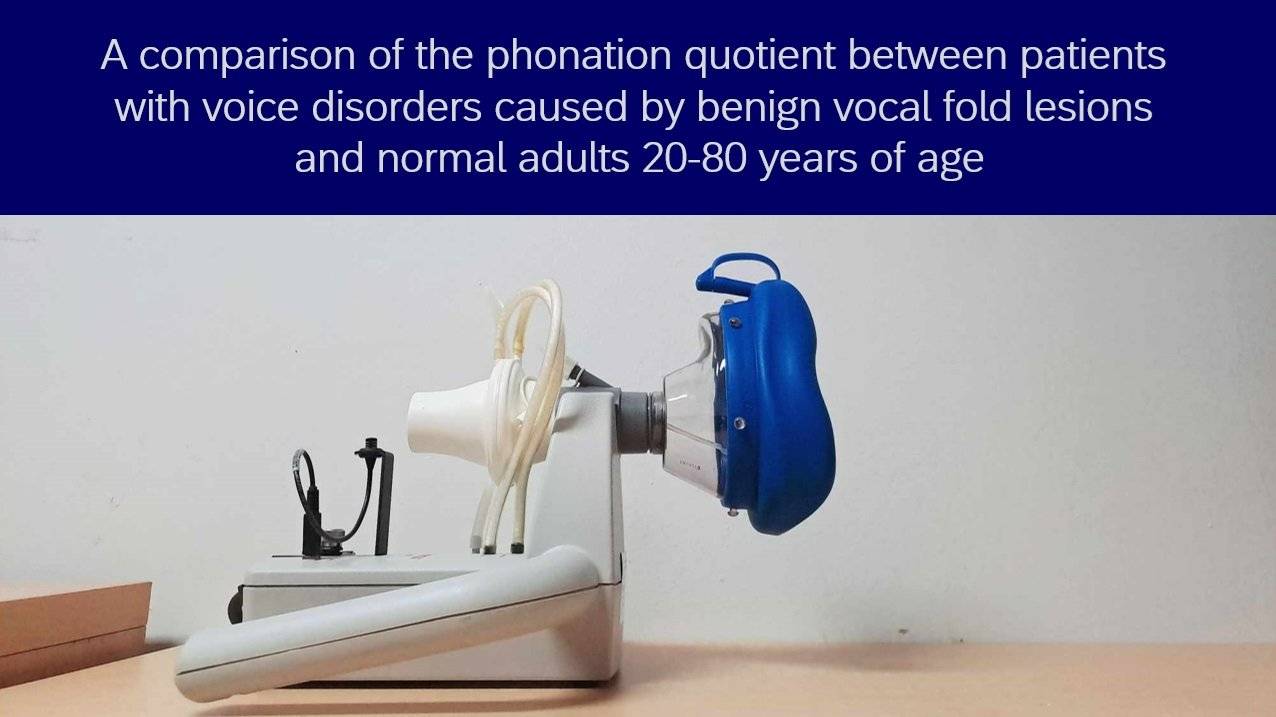A comparison of the phonation quotient between patients with voice disorders caused by benign vocal fold lesions and normal adults 20-80 years of age
Main Article Content
Abstract
Background: A voice evaluation is an important first step in analyzing voice symptoms and determining appropriate treatment plans. The phonation quotient is a valid aerodynamic parameter in voice evaluations which is an indirect source of information for evaluating the valve function of the vocal folds of patients with voice disorders, especially patients with voice disorders caused by tumors of the vocal folds which is the most common cause in the patients with voice disorders.
Objective: The present study aims to determine and compare the phonation quotient between patients with voice disorders caused by benign vocal fold lesions and normal adults between 20-80 years of age.
Materials and methods: The participants comprised 40 adults with voice disorders caused by benign vocal fold lesions and 40 with normal voices. All participants’ voices were evaluated in the Speech Clinic at Ramathibodi Hospital, Bangkok. The phonation quotient (PQ) was calculated by the ratio of vital capacity (VC) to the maximum phonation time (MPT). VC and MPT were measured using a phonatory aerodynamic system (PAS).
Results: The results of the present study indicated that the mean value of the PQ of adults with normal voices was 122.60 cc/sec (SD=16.36). The mean value of the PQ of adults with voice disorders caused by benign vocal fold lesions was 292.08 cc/ sec (SD=97.14). The mean value of the PQ in the group with voice disorders caused by benign vocal fold lesions was significantly more significant than the mean value of the PQ in the group with normal voice.
Conclusion: The significant difference between the phonation quotient of adults with voice disorders caused by benign vocal fold lesions and adults with normal voice was that the PQ might be an indicator for indirect evaluation of the airflow leakage related to the efficiency of vocal fold movement during phonation. The PQ can be the optional voice measurement for monitoring and analyzing the outcomes of voice therapy.
Article Details

This work is licensed under a Creative Commons Attribution-NonCommercial-NoDerivatives 4.0 International License.
Personal views expressed by the contributors in their articles are not necessarily those of the Journal of Associated Medical Sciences, Faculty of Associated Medical Sciences, Chiang Mai University.
References
Spina A, Maunsell R, Sandalo K, Gusmão R, Crespo A. Correlation between voice and life quality and occupation. Braz J Otorhinolaryngol. 2009; 75(2): 275-9. doi: 10.1016/s1808-8694(15)30790-4.
Wilson JA, Deary IJ, Millar A, Mackenzie K. The quality of life impact of Dysphonia. Clin Otolaryngol. 2002; 27(3): 179-82. doi: 10.1046/j.1365-2273.2002.00559.x.
Krohling L, Pereira de Paula K, Behlau M. Behavior, social competence, and voice disorders in childhood and adolescence. J Voice. 2016; 30(6): 677-83. doi: 10.1016/j.jvoice.2015.08.005.
Boone D, McFarlane S. The voice and voice therapy. 5th ed. New Jersey: Prentice Hall; 1994.
Stemple J, Glaze L, Gerdeman B. Clinical voice pathology: theory and management. 3rd ed. San Diego, CA: Singular Publishing Group; 2000.
Medical Records Section, Faculty of Medicine Ramathibodi Hospital. Statistical report of patients with communication disorders between 2016 and 2017.
Sataloff R. Vocal health and pedagogy. 5th ed. San Diego, CA: Plural Pub; 2006.
Baken R, Orlikoff R. Clinical measurement of speech and voice. 2nd ed. San Diego, CA: Singular Pub.; 2000.
Dejonckere P.H. Assessment of voice and respiratory function. In: Remacle M, Eckel HE. Surgery of larynx and trachea. Berlin Heidelberg: Springer-Verlag; 2010.
Hirano M, Koike Y, Von Leden H. Maximum phonation time and air usage during phonation. Folia Phoniatr. 1968; 20(4): 185-201. doi: 10.1159/000263198.
Iwata S, Von Leden H. Phonation quotient in patients with laryngeal diseases. Folia Phoniatr. 1970; 22(2): 117-28. doi: 10.1159/000263375.
Joshi A, Watts C. Measurement reliability of phonation quotient derived from three aerodynamic instruments. J Voice. 2016; 30(6): 773.e13-773.e19. doi: 10.1016/j.jvoice.2015.11.015.
Zemlin W. Speech and hearing science: anatomy and physiology. 4th ed. Boston: Allyn and Bacon; 1998.
Pal G, Pal P. Textbook of practical physiology. Calcutta: Orient Longman; 2001.
Limprasert N. Maximum phonation time and vital capacity in normal adult aged 20 to 40 years and the relations between maximum phonation time and vital capacity [Master’s thesis]. Bangkok: Mahidol University; 1997.
Aurichayapat P, Khrisanapant W, Aurvichayapat N, Thongaun T,Singhpoo K. Spirometric values in normal Thai. Srinagarind Medical J. 1996; 11(1): 27-34.
KayPENTAX Corp LP, NJ. Instruction Manual, Phonatory Aerodynamic System (PAS), Model 6600.
Thai Speech-Language and Heaing Association. The manual of the professional standards for Thai speech language pathologist. Khon Kaen: Khon Kaen Printing Ltd; 2000.
Dobinson C, Kendrick A. Normal values and predictive equations for aerodynamic function in British caucasian subjects. Folia Phoniatr. 1993; 45(1): 14-24. doi: 10.1159/000266205.
Morsomme D, Jamart J, Boucquey D, Remade M. Presbyphonia: voice differences between the sexes in the elderly. Comparison by maximum phonation time, phonation quotient and spectral analysis. Logoped Phoniatr Vocol. 1997; 22(1): 9-14. doi: 10.3109/14015439709075310.
Aghajanzadeh M, Darouie A, Dabirmoghaddam P, Salehi A, Rahgozar M. The relationship between the aerodynamic parameters of voice and perceptual evaluation in the Iranian population with or without voice disorders. J Voice. 2016; 31(2): 250.e9-250. e15. doi: 10.1016/j.jvoice.2016.07.014.
Joshi A, Watts CR, Hathway J. Phonation quotient using three aerodynamic instruments in the disordered voice. J Voice. 2020; 34(1): 20-4. doi: 10.1016/j.jvoice. 2018.08.002.
Ballenger W, Snow J, Wackym P. Otorhinolaryngology. Shelton, Conn.: BC Decker; 2009.
Vasconcelos D, Gomes A, Araújo C. Vocal fold polyps: literature review. Int Arch Otorhinolaryngol. 2019; 23(01): 116-24. doi: 10.1055/s-0038-1675391.
Bjerg-Jensen J, Rasmussen N. Phonosurgery of vocal fold polyps, cysts and nodules is beneficial. Dan Med J. 2013; 60(2): 1-5. PMID: 23461990.


